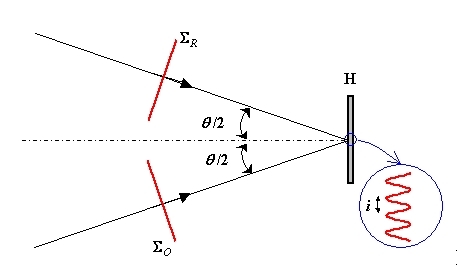
Constraints on digital recording
As has already been mentioned at the beginning of this course, a hologram is a speckle pattern (laser granularity) which corresponds to the interaction between a reference wave and a diffracted object wave, the latter also of “speckle” composition. In terms of zones, the interference fringes generated by two monochromatic plane wave, at an angle of
 , apart, have an inter-fringe distance (figure 12) of :
, apart, have an inter-fringe distance (figure 12) of :

The angle
 imposes almost no constraints in classical holography given the high resolution capability of analogue recording plates. The pixel pitch of current sensors, in digitally acquiring images, is limited. However, their resolution must be sufficiently high in order that the inter-fringe distance corresponds to at least 2 pixels.
imposes almost no constraints in classical holography given the high resolution capability of analogue recording plates. The pixel pitch of current sensors, in digitally acquiring images, is limited. However, their resolution must be sufficiently high in order that the inter-fringe distance corresponds to at least 2 pixels.
The Shannon theorem indicretes that for the correct acquisition of a given periodic signal, the sample frequency must be at least twice as high as the signal frequency. Otherwise, there would be a loss of information due to the weak sampling level. Thus, the first recording condition to be respected is that imposed by the Shannon criteria :
where
 is the sampling frequency and
is the sampling frequency and
 is the signal frequency which are being studied. Let's consider the case of a digital recording sinusoidal fringes; the sampling frequency
is the signal frequency which are being studied. Let's consider the case of a digital recording sinusoidal fringes; the sampling frequency
 corresponds to the inverse of the pitch between two consecutive pixels within the sensor (
corresponds to the inverse of the pitch between two consecutive pixels within the sensor (
 or
or
 depending on the studied dimension), and the studied signal frequency is the reciprocal of the inter-fringe distance
depending on the studied dimension), and the studied signal frequency is the reciprocal of the inter-fringe distance
 . That is to say :
. That is to say :
And
Since the size of the pixels is fixed, the spatial sampling cannot be increased. In order to create good recording conditions, the angle between the object and the reference beams must be adapted.
Thus, taking into account the three previous equations, the Shannon criteria results in the following disparity :
For a wave length of
 and a pitch between the pixels of
and a pitch between the pixels of
 , the maximum angle, corresponding to the limits of the Shannon criteria, is
, the maximum angle, corresponding to the limits of the Shannon criteria, is
 . The small angular deviation which is thus permitted between the two beams requires the use of a relatively precise adjustment device.
. The small angular deviation which is thus permitted between the two beams requires the use of a relatively precise adjustment device.